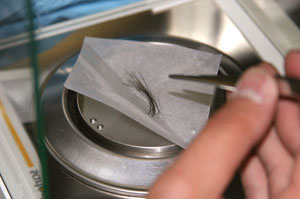Bills Introduced to Allow Hair Testing to Replace Urinalysis for Drug Use

“Preventing drug users from operating commercial trucks will improve safety on our roads and enhance industry standards,” Sen. John Boozman (R-Ark.) said. “This legislation eliminates the duplicative drug-testing process and allows trucking companies to use the more effective option without having to pay for two tests.”
Boozman introduced the legislation along with Sens. Joe Manchin (D-W.Va.) and Heidi Heitkamp (D-N.D.). The House bill was brought by Reps. Rick Crawford (R-Ark.), Dan Lipinski (D-Ill.) and Del. Eleanor Holmes Norton (D-D.C.).
Under current federal government regulations, urinalysis is the only acceptable testing method for the pre-employment and random drug testing that carriers must conduct on drivers and applicants.
Many consider hair testing more reliable. As a result, many carriers have been conducting hair testing for years in addition to the required urine testing, leaving them with duplicative expenses.
“By allowing companies to use more accurate alcohol and drug testing techniques to test those operating commercial vehicles, we will not only help combat the fight against substance abuse, but we will also help improve the safety of our roads,” Manchin said.
Rep. Dan Lipinski (D-Ill.) said, “Truck driving is a dangerous job and this bill helps take one danger out of the equation by allowing companies an additional option to choose from when testing their drivers to make sure they are following the law while behind the wheel.”
Bill Graves, president of American Trucking Associations, said: “ATA was an early advocate of mandatory drug and alcohol testing of drivers before it was required and has since promoted improvements, such as hair testing, and the creation of a national test results clearinghouse.”
The federation’s advocacy has resulted in a steady decline in “the small percentage of drivers who use drugs, and hair testing is the next logical step,” he said.
The bill’s sponsors said in a statement that “unfortunately, urinalysis is often less effective in detecting substance abuse, with only a two- to three-day window of detection, than hair testing, which provides a 60-90 day window.”
They cited data from May 2006 to December 2014 supplied by J.B. Hunt Transport Services that found that 110 driver applicants failed the urine test, while 3,845 people had tested positive for drugs- with hair tests.
“This discrepancy is causing many trucking companies to pay additional costs for both methods of testing,” the sponsors said.
“Some drug users, when they know that a drug test is likely, are able to abstain for just a few days before the test and beat the system,” Crawford said. “This bill would catch a much larger percentage of those drivers and keep them off the roads.”
Dean Newell, vice president of safety and driver training for Maverick USA, based in Little Rock, Arkansas, said that leading employers in a variety of industries around the world recognize that hair testing is a superior method.
“Hair tests are difficult to evade or subvert and provide a better window into an applicant’s potential history of drug use,” Newell said.

